In commemoration of ANZAC Day we continue our military theme with some photos of Australian soldiers around the turn of the 20th Century. While the soldiers will probably remain unidentified we actually don’t know where the military camp(s) is. They could be soldiers preparing for the Boer war or, perhaps, the photos even pre-date that era.
These photos are also available on Flickr. You can also view other military images on the photostream.
More from New England
Also stay tuned for another ANZAC Day post later in the week from Bill Oates, the University Archivist a the Heritage Centre University of New England.
Category: General


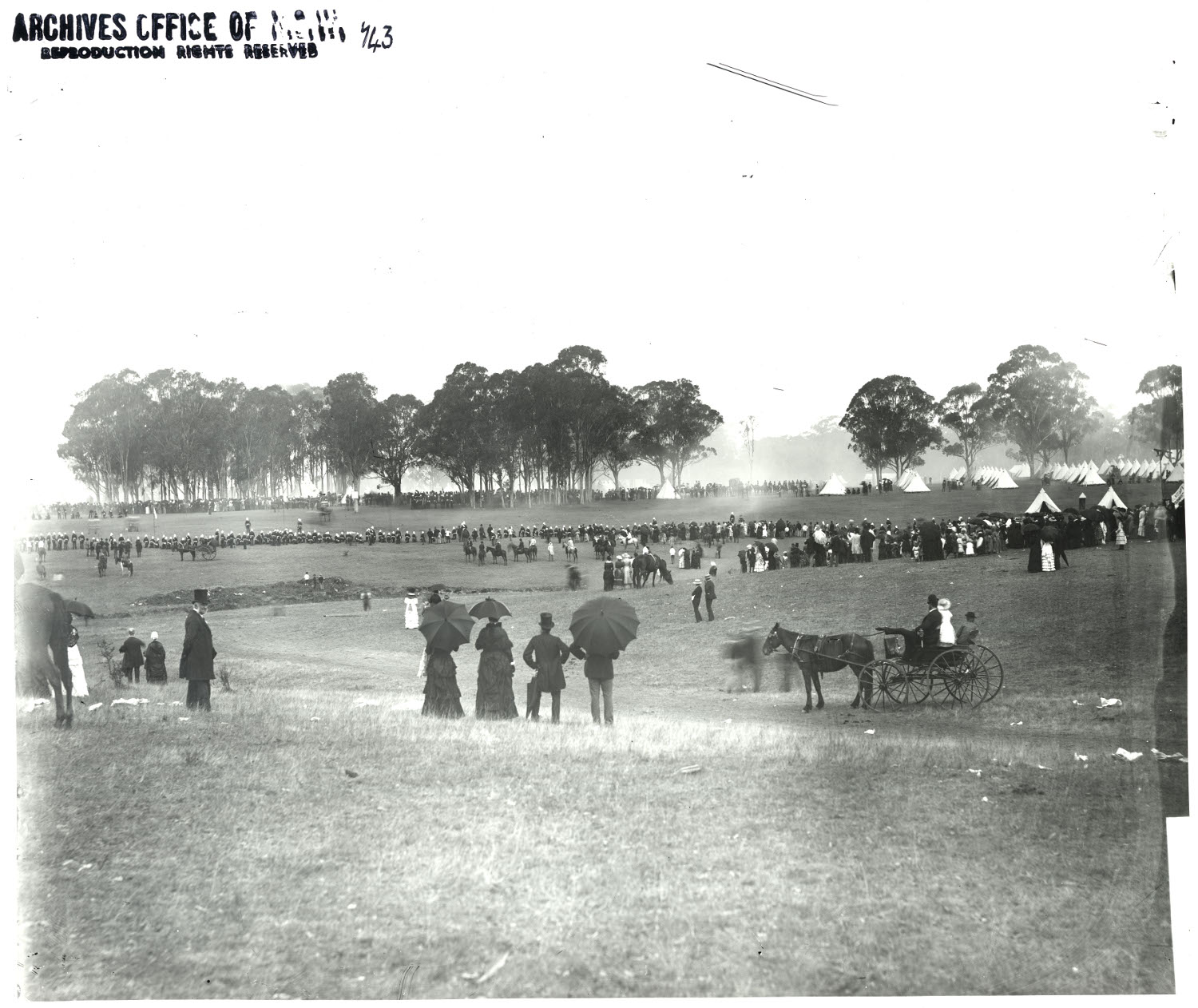
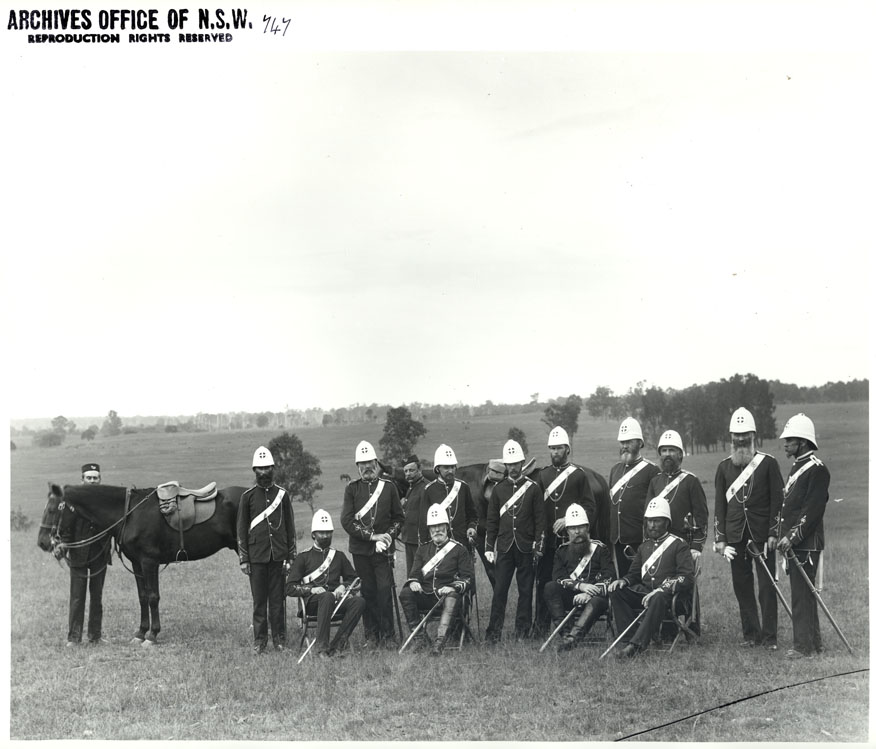

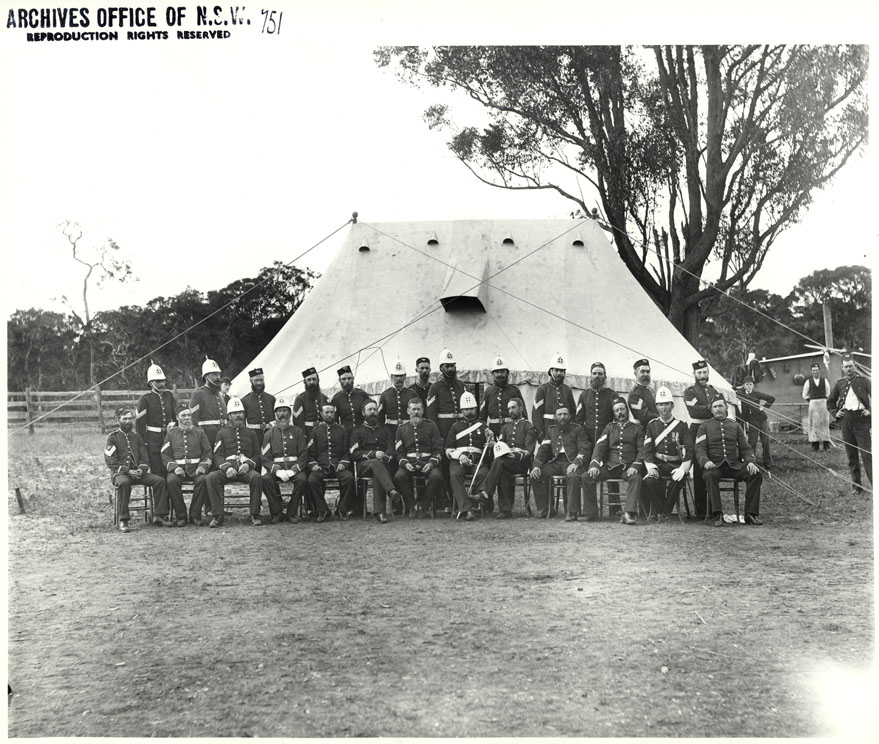
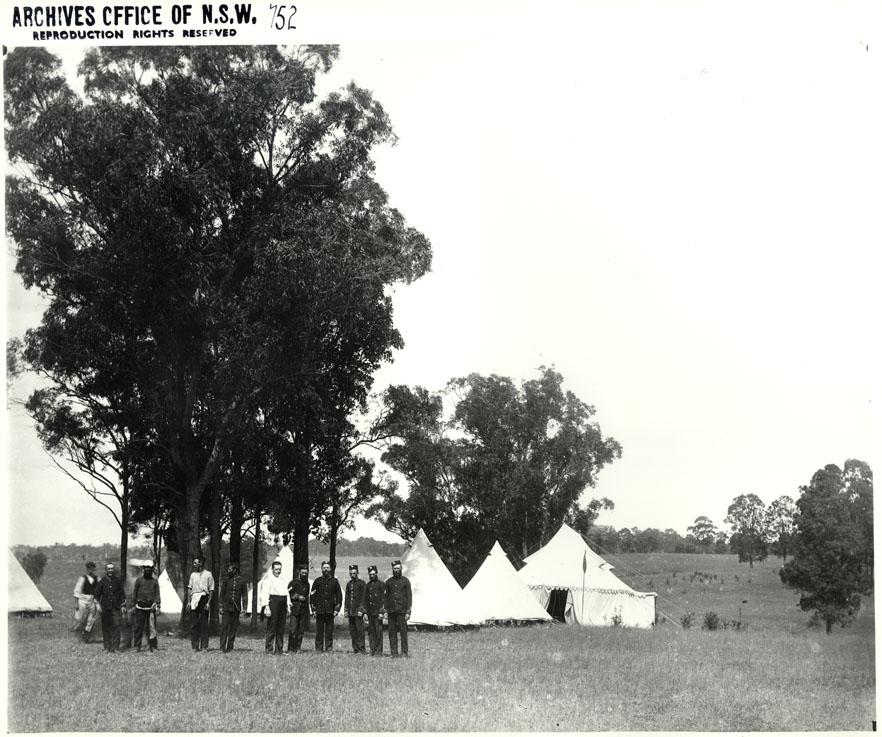

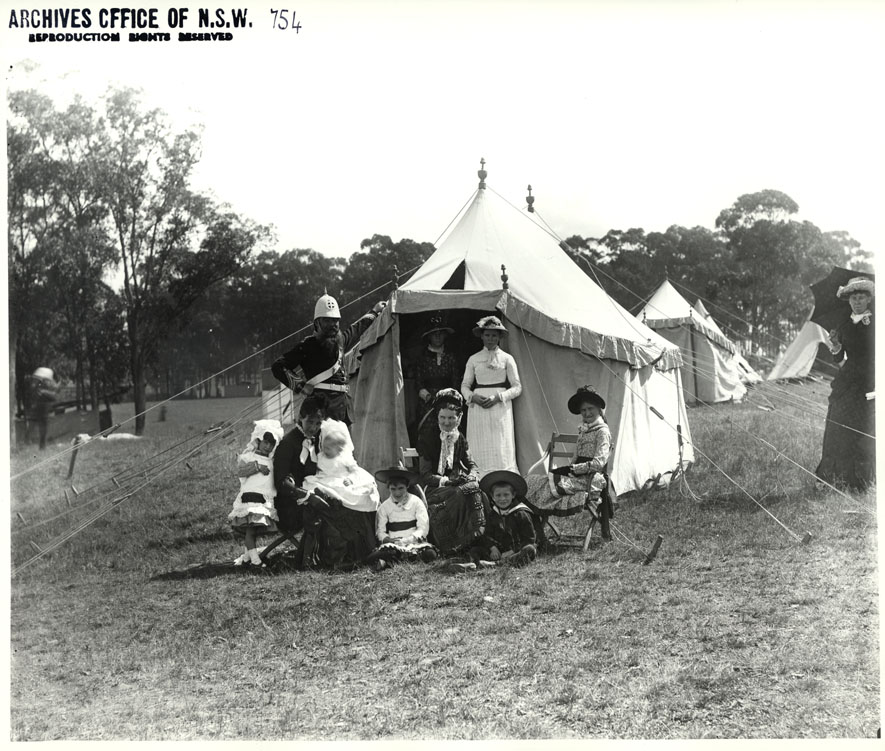
Bob meade says:
These are tough ones. I’ve had a good look and can’t come up with anything useful.
Anthea Brown says:
Thanks for looking, Bob, they are difficult. There is nothing (potentially) identifiable in the background. However the Australian fashion link you included in our Tips for Dating Photos might come in handy!
UPDATE: Rhonda Cetta-Hoye may be onto something here ->
Robert Mills says:
Unfortunately the topography does not look much like the Moore Park area, so I am inclined to think it is elsewhere. The landscape looks definitely rural – which is perhaps the key to unravelling the mystery.
My guess is that the images are taken in the 1870s soon after the NSW Colonial Military Forces were formed. All English units were apprently withdrawn by 1870. A news report in the SMH places the newly assembled NSW Colonial Volunteer troops at a camp near Campbelltown on 25th May 1874.
See
The Volunteer Encampment
http://newspapers.nla.gov.au/ndp/del/article/18784587?searchTerm=nsw+military
Could these be images from that encampment ?
A permanent military presence at nearby Liverpool appears to have been established in 1912 but the dress of the civilians in these images does not match that era. So its not Liverpool c1912.
Another location used by the early military was Loftus where the NSW artillery once had a firing range/parade ground. But this landscape is open terrain with occasional clumps of gums – Loftus it is not.
Does anyone have specific knowledge of the clothing being worn – especially the civilian clothing ? The ‘stove pipe’ hats of some of the men suggest the 1870s era to me…..
Can’t see any NSW Lancers present in these shots and they were not formed until 1885. Looks more like infantry (with white pith style helmets) and some artillerymen (wearing kepi style hats) present.
Cheers
Rhonda Cetta-Hoye says:
As The Victorian Barracks Sydney were built between 1841 – 1848
I feel this could be the mystery spot.
The presence of women, children and older people all dressed in fashions of that Victorian era, it appears to be an Open Day. The tents look festive.
The NSW Contingent to the Sudan trained there in 1885, could it have been a farewell of some sort for troops being deployed overseas ?.
Anthea Brown says:
I’d have to agree that the photos appear to pre-date the Boer War period. We might be able to narrow the date range to between 1870s – c.1885.
@Robert Mills thanks for this background information, especially the detail on the early Volunteer Forces.
@Rhonda Cetta-Hoye you could be on to something with an Open Day of sorts, or an official deployment farewell. There looks to be a parade in the top centre photo.
The location remains a mystery…
Jim Belshaw says:
I’m pretty sure that it’s the NSW Sudan contingent. If you look at the photo in the Australian War Memorial Sudan section, the uniforms look the same. The women’s clothing also looks 1880s.
I don’t think that the location is Victoria Barracks, although the contingent did train there. The countryside is open and does not fit the landscape around the Barracks. Further, there were already buildings around the Barracks. My best locational guess would be somewhere on the Cumberland Plain for field training. I suspect the best bet would be to check the archival record for the location of training pior to departure.
Robert Mills says:
If these images are from the Sudan Contingent era then they would date between February 1885 (when the decision to send an Australian contingent was ‘accepted’ by the Imperial Government in London following General Gordons death) and March 1885 when the troops were ‘on their way’ …
See SMH
http://newspapers.nla.gov.au/ndp/del/article/13587304?searchTerm=nsw+military
and
http://newspapers.nla.gov.au/ndp/del/article/13581395?searchTerm=nsw+military
I think the troops were armed with Martini Henry rifles – at the time a very modern weapon. Unfortunately no evidence of these particular weapons appears to be present in these particular images.
Jim Belshaw says:
Hi Robert
I realised that I didn’t give the AWM link – http://www.awm.gov.au/atwar/sudan.asp
According to the War Memorial, the Sudan contingent were issued with those rifles in the Sudan, along with Khaki uniforms.
Robert Mills says:
Hi Jim
Yes the absence of Martini Henry rifles supports the view that these images could pre date the departure of the Sudan Contingent. They could well be images of the men in training and the festive nature of the images, as noted by Rhonda, supports this interpretation.
But there appear to be light cavalry units present in the photos (the soldiers with long and relatively straight swords) and according to the AWM site only one infantry battalion and one artillery battery were sent by NSW –
“an infantry battalion of 522 men and 24 officers and an artillery battery of 212 men” – no cavalry.
Curious.
Bel Gibson says:
Hi all,
I have a copy of an article from the Sydney Morning Herald from Nov 5 1886 talking of one of the first encampments of the Reserve Corps (about 500+ men) to be held at Field of Mars (out the back of Ryde?) is it possible these photos are from there? I know of the areas around Campbelltown where it is cosidered that some of these training exercises were held but it is fairly hilly and these look fairly flat. The hat looks similar to a photo of my great great grandfather taken after the Sudan Campaign but his has a scarf around it,
Hope this helps.
Carol says:
Could these photographs relate to early police officers instead of military personnel? The kepi cap was introduced after 1862 and the brass buttons on the tunics are very similar to those on http://www.policensw.com/info/history/h6.html. Unfortunately, this website does not indicate the uniforms worn prior to 1862. . . just a thought.
David Patton says:
I note you are trying to locate eight photographs taken in an encampment of the era 1870 – 1890 that are displayed on your website, here: http://archivesoutside.records.nsw.gov.au/australian-soldiers-in-black-and-white/ .
I am familiar, from past military service at Ingleburn, with the landscape north of Campbelltown, NSW, and the image ‘Soldier – Digital ID 4481_a026_000695’ certainly does not seem out of place with regard to that general location. I note a copse of Casuarina trees (belah?, she-oak?, river oak? bull oak?) behind the right-hand end of the group in this photograph: such vegetation, while not dominant in the mainly eucalypt woodland, does occur in that general locality.
The newspaper report of the May 1874 encampment contained within the link given in the comments on this webpage by Robert Mills on April 30, 2010 at 3:58 pm, titled ‘The volunteer encampment’, http://newspapers.nla.gov.au/ndp/del/article/18784587?searchTerm=nsw+military , gives the site of that encampment as being “about three miles on the Sydney side of Campbelltown”.
TBC, on account of your spam filter.
David Patton says:
Continued from post of 1 January, 2011 at 8:37 am
The site itself is described as being “Campbell Fields” in that newspaper report. “Campbell Fields” was a property name of that era, being the name of William Redfern’s original land grant near what later became known as Campbelltown. The presence of the number of visitors to the encampment evident in the photographs could be indicative of relative proximity of that encampment to rail transport. The railway station now known as Minto was formerly known as Campbell Fields, see: http://bit.ly/g2zcxO .
I am in possession of a 6.5″ X 4.75″ (165mm X 120mm) print of a ‘head and shoulders’ portrait photograph of a soldier circa 1870 – 1890. If I had to guess, I would say the subject may have been a member of the NSW Sudan contingent of 1885. Pith helmet plate and collar badges are clearly displayed, and there is a puggaree* around the helmet, but I am not familiar with the badges. The portrait print dress is very similar to the dress shown in your series of encampment photographs.
Written on the back of the photographic print in very neat and legible copperplate handwriting is the inscription:
“J.Shuack
Woodbine
Minto”
Whether there is any connection between the locality written on the back of the ‘head and shoulders’ portrait, and that of the encampment shown in your archived photographs, I cannot be sure, but the relative interchangeability of the names ‘Minto’ and ‘Campbell Fields’ seems significant. Perhaps there were numerous encampments in that locality over the years between 1874 and 1885. It is perhaps significant that there are no helmet plates worn in the series of photographs you are attempting to date and locate, whereas the soldier in my portrait print has both helmet plate and collar badges: perhaps badges had not been designed and/or manufactured as at the time of the photographed encampment?
TBC, courtesy of the spam filter
David Patton says:
Continued from post of 1 January, 2011 at 8:44 am
Encampments of the nature of the one reported upon in the newspaper article would have been just such events as to have attracted the relatively few photographers of that era as a commercial opportunity. Perhaps the photographer(s) used the property ‘Woodbine’ as base, being perhaps both the location of the portrait shoot, and providing facilities for development and printing of the photographs. I should imagine any photographer would have preferred to deliver the finished product and be paid on site, rather than have to deal with the delays and uncertainties of postal transactions after those attending had dispersed.
It seems the property ‘Woodbine’, described in this linked document as ‘Woodbine cottage’, was located north of Campbelltown on the Sydney road, just north of a bridge which crossed the railway line. See: http://www.campbelltown.nsw.gov.au/default.asp?iDocID=2104&iNavCatID=322&iSubCatID=1393 . That would place the ‘Woodbine’ of the portrait photograph in the general vicinity recorded for the 1874 (and possible subsequent) encampment. The linked document also contains an interesting footnote to the 1975 naming of the suburb ‘Woodbine’ by Campbelltown City Council.
I suggest there is sufficient topography recorded in your image ‘Soldier – Digital ID 4481_a026_000695’ such that comparison with photographs taken on or near what was once the William Redfern property “Campbell Fields” may well confirm (or eliminate) that as the location. Probably any landscape photograph taken prior to 1975 would suffice. An experienced user of 1:63360, 1:50000, or 1:25000 scale topographic maps may be able to narrow down the search area for relevant comparison photographs, or even confirm from your image itself, the likely locality of the encampment.
Although it seems to have been an overcast day, I get the sense that the shadows of the group fall generally behind them. If it is accepted that a May date applies to the photograph, then the viewer is looking generally to the south, placing the location somewhere on the western side of the valley, if it is indeed near Campbelltown. It would not be possible at any time of day in May to be looking north with shadows falling behind the group. The valley there runs north – south.
It is to be noted that in image ‘Soldiers with families – Digital ID4481_a026_000703’ there are shadows clearly visible. That photograph, if taken in May, is either a morning photograph taken looking south, or an afternoon photograph looking north-east. Taking into account the likely logistics for visitors, an afternoon shot is the more likely. In those days of relatively slow photographic emulsions, photographers tended to want the best light falling upon their subjects, and for the lens to be pointing away from the sun.
The photograph ‘Watching soldiers at a military camp – Digital ID 4481_a026_000691’ also gives the impression of being taken around midday looking approximately south-west. The land falls from right to left, that is, from west to east generally, thus likely placing the location on the east slope of higher ground.
*According to one website I have visited, the (red) puggaree around the helmet became part of the uniform after arrival of the NSW contingent in the Sudan in 1885. Its appearance in the portrait photograph would therefore indicate that it was taken after the subject had returned to Australia. It may have been simply co-incidence that the ‘Woodbine’, Minto, location recorded on the back of the print was near to where encampments of the like of the one featuring in the NSW archives series of images had taken place.
David Patton says:
The ‘J.Shuack’ of my earlier post of January 1, 2011 at 8:44 am, I now realize was a misreading of the handwriting on the back of the print. The correct reading was:
“J.Sherack”
John Joseph Sherack of Minto, NSW, was born in 1864. That would have him as the subject of the print at around 20 years of age shortly after a return from the Sudan expedition of 1885. Such an age looks right for the photograph.
As a child and a local to the area in which the 1874 encampment was held, he could perhaps have had his imagination fired by having seen that event. As a young man of around 20 he may have been more enthused by the prospect of a land grant attached to service in the NSW military force of that era.
The Sherack family lived on the Ingleburn side of Minto around 1885. The property ‘Woodbine’, where the photograph was purportedly taken, would only have been a few kilometres away from where he then lived.
As a matter of interest, the text link http://www.awm.gov.au/database/sudan.asp to the nominal roll for the Sudan contingent on the Australian War Memorial web page ‘Sudan (New South Wales Contingent) March-June 1885’ yields a ‘404 message – page not found’. As a consequence I have not so far been able to confirm John Joseph Sherack as having served under his own name in that contingent.
It is my intention to lend or donate, as appropriate, the photograph of J.Sherack in my possession to the NSW Archives after having made an appropriate number of copies for myself and descendants of the Sherack family that may be interested. Because of the age of the print I have been reluctant to actually attempt anything of this nature with it. Can you advise what may be able be done?
Anthea Brown says:
Thank you for your comments @David Patton. You have certainly carried out some in-depth research here; it is sure to generate interest with our other readers!
Regarding your question about donating/lending a photo you could contact the Australian War Memorial or the State Library of NSW about this as our archival collection contains only official records from NSW government departments. One link that may be of interest to you is advice on ‘Preserving Photographs’ by the National Archives of Australia.
Allan Cole says:
Mr David Patton,
I was very interested to read your post about a Mr J. Sherack. My interest as a descendant of one of his siblings is to confirm or prove incorrect the involvement of J. Sherack in the New South Wales Contingent to the Sudan in 1885. You mention that you have a photograph in your possession. Is it possible to obtain a copy of this photograph in some way. I am also familiar with some other members of the Sherack family.
Michael Waterhouse says:
I’m unable to identify the camps, but the photo at the following link may help: http://acms.sl.nsw.gov.au/item/itemDetailPaged.aspx?itemID=901221
The photo is of my great grandfather, Gustavus John Waterhouse, and until I discovered it a few days ago, I had no idea he’s been in the NSW Volunteer Forces. His fathr was a Methodist Minister which makes his involvement a little surprising. But the fact that he was a sergeant-major suggests he may have been in the Volunteer Forces a while. He looks to be about 21-22 here, which suggests a date of early 1870s as he was born in 1850.
There are a couple of sergeant-majors in the image 4481_a026_000697.jpg whose uniform and position of stripes looks to be the same.
The photographer Jacob Audet worked in Newcastle in the early 1870s. If one assumes (and it’s not unreasonable) that he may have had the photo taken at the time he attended a camp, then the camps in the NSW Archives photos may be in the Newcastle area. (It may or may not be relevant that GJW lived in Maitland in the mid to late 1860s and perhaps into the 1870s.)
Allan Cole says:
Anthea Brown,
I realise that the Volunteer encampment article is before the Sudan contingent but after reading it I found it referred to the Forbes Hotel in Campbell Fields now Campbelltown area. This hotel was once run by a Mr Joseph Sherack and they had property at Minto nearby. Mr Patton has found a photograph of Mr J. Sherack Woodbine Minto which I believe to have been his brother John. I therefore think that the scene may well be on or near the Sherack property which was at Minto.
Anthea Brown says:
Thank you for your interest in these military photos, @AllanCole. I think we might write another post to highlight them as you have discovered much information and provided an interesting commentary.
@MichaelWaterhouse thank you for linking to the State Library photo, what a wonderful find for you. He certainly looks younger than some of the heavily bearded soldiers in the photos above!
Allan Cole says:
Mr David Patton,
My apologies for having to contact you this way. I have received a copy of a photograph of J. Sherack in the army reserves about 1902. The soldier is wearing a pith helmet similar to the Sudan soldiers and with a dark coloured cloth
around his helmet with a badge above it. His uniform is a consistent khaki colour with single epaulettes and what look like brass buttons. He carries a stick under his right arm and has a bayonet on his left hand side. Is this similar to your photograph?
Allan Cole says:
Mr Waterhouse, Something you probably know already. In “Australian Military Uniforms 1800-1982” by Monty Wedd there is a picture of a private in Sydney Battalion, 1st New South Wales Rifle Volunteers, 1861. The soldier pictured has a pair of crossed muskets on his left hand sleeve and a belt similar to your photograph. The man in your picture
presumably is before 1870 and after 1861.
Allan Cole says:
This is only a possibility. The officer of the New South Wales Infantry 1885 seated in the front row second from the right in the top right picture ID 695 and the officer with the family group in the last middle picture ID 702 look to be the same person. Both wear their helmet straps in the same way and look similar in other ways.
Allan Cole says:
Do we know what type of photographs these are? e.g. are they wet glass plate negatives, dry plate ngatives or some other.
Allan Cole says:
The families in ID 701 and 702 are probably the same as one of the seated women looks very much like one of the seated women in the other photograph. Whilst they are similar I suspect a time difference of some years to explain the young children in one photograph and the age of the man.
Allan Cole says:
Below is some information on Volunteer Encampments based on Trove and the Sydney Morning Herald. 1882 It seems it was spread over Victoria Barracks, Middle Head, Moore Park and Windsor Farm. 1883 also seems to have been at Windsor Farm.1884 first mounted corps “Light Horse” were established and infantry was at Windsor Farm and Middle Head. 1885 “Light Horse” were converted to Lancers. Campbellfield Estate seems to be being subdivided. In the light of the Soudan contingent recruitment to the volunteers seems to have been very good.1886 National Park and Port Hacking.It also appears that Mr Russell’s farm near Campbelltown was used at this time.It appears the infantry were wearing scarlet and the artillery a dark blue at this time.1887 Camden Parade at St John’s church Camden. Earlier in 1860 it appears that ” Old Campbelltown Racecourse” was used though a station had yet to be built within about a quarter of a mile of the course. 1873 Ham Common 1 mile from Richmond. 1874 Campbellfields Racecourse.1877 saw the introduction of the Volunteer Militia Bill by Colonel John S. Richardson.
He was commandant of all NSW forces and was later to command the Soudan Contingent.
Allan Cole says:
With the assistance of Campbelltown City Library I determined that the racecourse mentioned in my previous post is probably what we now know as Leumeah at about Rudd Rd and O’Sullivan Road. I would of course welcome any corrections to my posts.
Allan Cole says:
My earlier statements about encampments seem to be confirmed by an article inthe Sydney Morning Herald of 22nd of April 1905 page 6 titled ” Concerning Easter Trainings”.
kate says:
hi im looking for a photo of a guy called lawrence carroll. i need a photo of him for a family project and i was wondering if you had any of him. if you do please let me know where i can find one
Fiona Sullivan says:
Hi @Kate! Can you tell us a little bit more about Lawrence Carroll? Was he a soldier? When was he born? Was he an MP? etc. I may be able to give you some useful referrals with a bit more information.
Jenny says:
Thank you to Alan Cole for pointing State Records in the direction of the NSW Volunteer Infantry encampments. Based on the helmet plates which were introduced in early 1883 the images appear to have been taken at Windsor.
Thanks to the comments of Bob Meade on flickr, an image that is related to these has been identified as Sergeants of the 2nd Regiment of the Voluntary Infantry, Easter Encampment, at Windsor in April 1884. http://archivesoutside.records.nsw.gov.au/staff-pick-soldiering-in-the-late-19th-century/
The above are some of forty images that State Records have grouped together on our flickr account because we believe they are of the NSW Volunteer Infantry at an Easter Encampment at Windsor, in either March 1883 or April 1884. See our Easter 2014 blog http://archivesoutside.records.nsw.gov.au/what-are-your-easter-memories-church-show-bags-and-chocolate-eggs-easter-encampments/
You can find a link to all forty of the images throught this article.
Thank you also to Sean Ryan for his detailed comments on the uniforms in the photos
http://archivesoutside.records.nsw.gov.au/australian-soldiers-in-black-and-white/4481_a026_000699/
http://archivesoutside.records.nsw.gov.au/australian-soldiers-in-black-and-white/4481_a026_000695/
Jenny
Elise Woods says:
Hi Allan Cole and David Patton,
I am a direct descendent of John Sherack. He is my Great Great Grand father. I have never seen the photo of him in the Army Resreves. Would there be any chance that I could somehow get a copy? Even if it is just an image sent via email?
Regards Elise Woods
Don Audet says:
The photographer,Jacob Audet, mentioned in the blog was my great grandfather who operated the first photography studio in the Hunter at Maitland during the 1850s and early 1860s and moved to Sydney around 1863 after my grandfather was born.